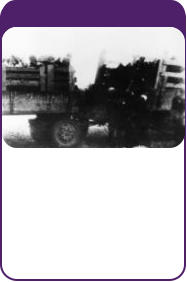


Defence
Each of the ethnically mixed communities which had existed on the old borders of Poland and Lower Silesia bore the brunt of the first days of the Nazi invasion of Poland; which commenced on 1 September 1939. The defence of the border lands were inevitably inadequate to withstand the Nazi war machine and within a few days the whole area was overwhelmed. In consequence many of the small towns and villages were partly or completely destroyed and thousands of people were made homeless. This was, as we now know, a precursor to the harrowing decimation and ultimately complete annihilation of communities throughout the region. However, perhaps because of its fairly isolated location, Osjaków remained relatively unscathed, which left the village available for the Nazis to use as their gendamerie headquarters from where they undertook to persecute the whole Polish community (Jewish and Christian) of both the village and the surrounding area of towns and villages; an area which had been incorporated into the German Reich.Nazi Occupation
Of a total population of 13,438 people living in the general municipal area which included Osjaków, 737 (5.48% of the population) were Jewish. The vast majority (674) were residents of Osjaków; who were mostly engaged in trade and crafts. The Nazi authorities immediately issued several decrees against the Jewish population including banning them from trading and requiring them to wear the distinctive yellow star. The Nazis then began the process of implementing a plan to expel the indigenous Jewish population as part of their overall Warthegau Plan to ‘Aryanize’ this region through the removal of both Polish Jews and Christians; in preparation for the region’s annexation into the Nazi German Reich. The local implementation of the plan required the Jews of Osjaków to be concentrated into a ghetto and then deported to what was called the General Government area to the east of Lódz. After the Nazis occupied Osjaków (September 1939), a portion of the indigenous Jewish community either left the town or were expelled to other places. During the first days of the occupation, the rabbi of Osjaków arrived in Piotrków Trybunalski, and on Rosh Hashanah 5740 he was imprisoned along with a group of Jews by the Nazi authorities. After the Germans tortured them, they sent them in a truck to an unknown destination.Imprisonment and Liquidation
More or less immediately, a Judenrat (Nazi imposed Jewish Council) was established in Osjaków at the command of the authorities. At the end of October 1939, there were about 600 Jews remaining in the village. In 1940/41, they were gradually evicted from their homes and concentrated into the ghetto in the town. From the ghetto, a portion of them were sent to slave labour camps, and it is almost certain that some Jews of Osjaków were sent to the ghetto at Belchatów. For the next period, whilst the Nazi Reich ‘readjusted’ it plans - the Jewish community of Osjaków - in common with other communities in the region - remained oppressed prisoners of the Nazis. In 1942, approximately 500 Jews, who were uprooted from nearby municipality of Kielczyglów, were transferred to Osjaków. This act of concentration was one of the preparations for the final destruction of the Jews in Wieluń county. According to information contained in the Kielczyglów website, members of the Polish community from Kielczyglów gathered food and brought it to Osjaków. However, the Nazis did not allow the Jewish prisoners to receive the food and the Poles who had taken the it to Osjaków were beaten.A Shared Life and a Shared Fate
In the middle of August 1942, the Nazi Authorities closed the village church in Osjaków and forced the Jewish men women and children into the church where they remained for several days without food. Those who were most fit were chosen for slave labour and sent to the Lódz ghetto, and the remainder of the Jews were deported to the Chelmno death camp. At this same time the Nazi Authorities also began their anti Polish activities of selective imprisoning, murder and deportation. Having closed the town school and town church (its use was prohibited to the local population for the duration of the war) the parish priests were deported to Dachau concentration camp, several tens of local Polish people were executed and several hundred Poles sent into slave labour. The memory of the former Jewish community is remembered in a number of ways; in the memorial to the victims of Nazi terror which is in the centre of the village (representing the whole of the former community of Osjaków); in the Jewish cemetery with a few remaining matzevot (gravestones) and, most importantly, in its synagogue building.
Deportation
A photograph taken in August 1942
of the transportation of Jewish
people from Osjaków (possibly
including people originally from the
Jewish communities of Kielczyglów
and
Działoszyn
) to the death camp
at Chelmno - photograph courtesy
of the Wielun Museum.
Compiled by Martin Davis © 2017

Yizkor - In Memoriam
A photograph of the memorial
to the Jewish victims of the
Shoah from the Wielun region
of Poland - including Osjaków -
in the cemetery of Kiryat Shaul,
Tel Aviv, Israel.

Sources
Osjaków - The Encyclopaedia
of Jewish Communities in
Poland, Volume I (Poland) -
Pinkas Hakehillot Polin -
Translated by Morris Wirth
The Osjaków Information
website.
AP [Archiwum Panstwowe] Lódz:
Piotrkowski Urzad Wloscianski
106.
Y Goldberg, A. Wien, "The
Book of the Community of
Dzialoszyn" in "Pages of History"
1966, volume 16, pages 159, 161-
162, 170-171.
"The Book of Kalisz", Tel Aviv
1967, volume 2, page 574.
"Di Zeit", 1931, issue 35.

Patriotic Ceremony
Part of a photograph taken
circa 1939 at a patriotic Polish
homeland ceremony in
Osjaków showing members of
the orthodox Jewish community
in attendance alongside their
fellow villagers (see gallery for
main photo).
















